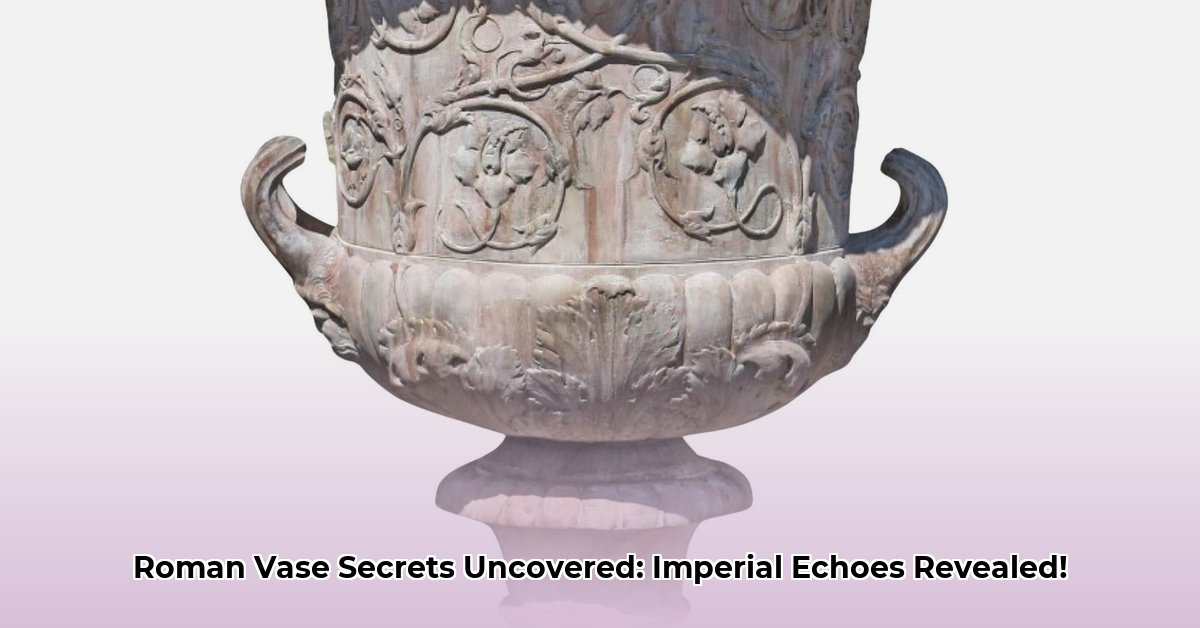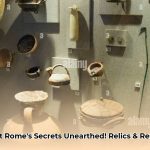## Ancient Roman Pottery: Decoding Imperial Life, Trade, and Enduring Legacies
Ever stumbled upon a broken piece of pottery and wondered about its story? Ancient Roman pottery, though often appearing utilitarian, is a rich archaeological treasure trove. These ubiquitous fired clay artifacts – from elegant tableware to sturdy storage jars – were produced in astonishing quantities and are found across the vast expanse of the former Roman Empire and beyond. Far from being mere fragments, they serve as invaluable time capsules, offering profound insights into the daily lives, intricate trade networks, and remarkable technological achievements of one of history's greatest civilizations. Learn more about their story through [Roman artifacts](https://www.lolaapp.com/ancient-roman-artifacts/).
This comprehensive guide delves into the fascinating world of Roman ceramics. We will explore the distinct categories of pottery, illuminate the diagnostic power of key types like *terra sigillata*, and reveal the pivotal role of amphorae in the Roman economy. You'll learn the practical methods archaeologists employ to identify and date these vessels, discover the sophisticated production techniques that fueled an empire, and even glimpse how modern technology is revolutionizing our understanding of these ancient echoes. Prepare to uncover the secrets hiding in these ancient pots – their significance is far greater than you might imagine.
### Key Insights from Roman Pottery
* **Archaeological Time Capsules:** Roman pottery provides direct, tangible evidence of ancient daily life, dietary habits, and social structures.
* **Chronological Markers:** Distinct pottery types, particularly *terra sigillata* and specific amphora forms, are fundamental for precisely dating archaeological layers and sites.
* **Economic Barometers:** The widespread distribution and standardization of vessels like amphorae reveal the complexity and scale of Roman trade routes and economic interdependence across provinces.
* **Technological Prowess:** Analysis of pottery fabric and manufacturing techniques showcases Roman innovations in mass production, kiln technology, and material engineering.
* **Cultural Narratives:** Decorative motifs on fine wares and lamps offer glimpses into Roman aesthetics, popular beliefs, and mythological stories.
## Ancient Roman Ceramics: A Legacy in Clay
Roman pottery, while sometimes overshadowed by the vibrant artistic traditions of Greek vase painting, holds unparalleled significance for understanding the immense scope and day-to-day operations of the Roman Empire. Its sheer volume and pervasive presence across all social strata and geographical regions make it an indispensable tool for archaeologists and historians. The abundance of finds, such as Monte Testaccio in Rome – a colossal artificial hill composed almost entirely of discarded amphora sherds, predominantly from Spanish olive oil – vividly illustrates the scale of Roman ceramic consumption and trade.
### Categorizing Roman Pottery: Function and Form
Roman domestic pottery is broadly classified into two main categories based on their intended use and appearance: coarse wares and fine wares.
* **Coarse Wares:** These were the practical, everyday pottery jars, dishes, and bowls. They served essential utilitarian purposes such as cooking, the storage and transport of foodstuffs, and in some cases, even rudimentary tableware. Coarse wares were typically produced and primarily distributed locally, reflecting regional clay sources and artisanal traditions. Their robust, unrefined composition was prioritized for durability in daily use.
* **Fine Wares:** In contrast, fine wares were refined serving vessels or tableware, elegant in appearance and often used for more formal dining occasions. Many of these sophisticated pieces originated from specialized pottery workshops and were frequently traded over substantial distances, circulating not only within but also between different provinces of the Roman Empire. Their quality and decorative elements often mimicked more prestigious metalwork.
The widespread use of fine pottery, unlike the exclusive luxury of Roman glass (which was often paired with gold or silver tableware by the elite), meant that quality ceramics were accessible to a far broader segment of Roman society.
### *Terra Sigillata*: The Empire's Iconic Tableware
A premier example of Roman fine pottery is the elegant red-gloss ware known as *terra sigillata* (Latin for "stamped earth" or "sealed earth"), also frequently referred to as Samian ware. Produced extensively from approximately 30 BCE to the 3rd century CE, this distinctive pottery features a highly polished, shiny surface ranging in color from light orange to an intense, vibrant red.
Its production began to flourish around 30 BCE in the province of Arretium (modern-day Arezzo in Tuscany), giving rise to **Arretine ware**. This early *terra sigillata* was renowned for its exquisite quality and delicate relief decoration. Potters achieved this decoration by pressing clay into molds that had intricate designs impressed upon their interior surfaces using individual stamps, or *poinçons*, and small wheels bearing repetitive motifs like the popular *ovolo* (egg-and-tongue) pattern. This molding process allowed for faster, standardized production while maintaining a high-quality appearance.
As production in Arretium waned around the 1st century CE, manufacturing prominence shifted to Gaul (encompassing parts of modern France and Germany). **Gaulish *terra sigillata***, or **Samian ware**, became the dominant type, characterized by thicker wares, a slightly higher gloss finish, and a wider range of red hues. By the 3rd century CE, potteries in North Africa began carrying on the red-ware tradition, producing **African Red Slip (ARS) ware**. ARS ware typically had a more subdued reddish-orange slip, and while it continued the tradition of relief decoration, it often replaced the full-mold technique with the application of separately made motifs (*appliqués*) and stamped designs.
Fragments of *terra sigillata* are invaluable for archaeologists, serving as exceptionally precise chronological markers. The subtle variations in fabric, form, and decoration allow specialists to pinpoint their exact origin, production date, and even specific workshops. This diagnostic capability is critical for understanding archaeological stratigraphy – the layering of deposits at a site – and reconstructing the timelines of ancient settlements.
## Identifying Ancient Roman Pottery: A Practical Guide
Encountering a pottery fragment and suspecting it's Roman is the first step in a rewarding archaeological detective process. Deciphering **how to identify ancient Roman pottery** involves a systematic approach, combining keen observation with specialized archaeological knowledge.
### Deciphering the Clay: Fabric Analysis
The "fabric" of a pottery sherd refers to the clay body itself – its fundamental composition, texture, and color. Roman potters utilized a vast array of local and imported clays.
* **Color:** The fired color of the clay can range from pale buff to vibrant orange, red, grey, or even black. This is influenced by the iron content in the clay and the firing conditions.
* **Texture:** Is the clay fine-textured and smooth, or coarse and gritty? Fine-grained clays were often used for delicate fine wares, while coarser clays were reserved for robust utilitarian vessels.
* **Inclusions:** Are there any visible particles within the clay body? These "inclusions" (known as temper) can include sand, mica, crushed rock, shell, or even ground-up pottery sherds (grog). The type, size, and quantity of inclusions provide crucial clues about the pot's geological origin and the potter's specific manufacturing techniques. This meticulous examination is a foundational step in identifying provenance.
### Form and Function: Understanding Its Purpose
A pot's shape, or "form," often directly indicates its intended function within Roman daily life. Roman practicality dictated that distinct shapes served specific purposes.
* **Amphorae:** Large, two-handled vessels designed for transporting bulk liquids like wine, olive oil, and *garum*.
* **Mortaria:** Robust, shallow, bowl-shaped vessels with a thick, out-curved rim, often a pouring lip, and an intentionally roughened interior surface (infused with grit or coarse sand) used for grinding and mixing ingredients.
* **Caccabi, Ollae, Patellae:** Earthenware cooking vessels, including large stew pots (*caccabi*), smaller pots (*ollae*), and pans (*patellae*), specifically designed to withstand heat and daily use in Roman kitchens.
* **Jugs, Dishes, Bowls, Cups:** A wide variety of forms for serving, eating, and drinking, ranging from simple coarse ware iterations to elaborately decorated fine ware versions.
Recognizing the form immediately offers insights into the vessel's role in Roman daily life and societal practices.
### Decorative Details: A Glimpse into Roman Aesthetics
Decoration can be highly informative, reflecting regional artistry, popular motifs, and technological capabilities.
* ***Terra Sigillata***: Renowned for its glossy red surface, often adorned with intricate molded patterns depicting flora, fauna, mythological scenes, or everyday life. These were created by pressing wet clay into relief molds.
* **Painted Designs:** While less common than Greek painted pottery, some Roman wares featured painted geometric patterns or occasional figural scenes.
* **Incised Patterns:** Linear or geometric designs scratched into the clay before firing.
* **Applied Relief Motifs (Sprigs/Barbotine):** Separately molded decorative elements (*sprigs*) could be applied to a vessel's surface, or designs could be created by trailing fine lines of liquid clay (*barbotine decoration*).
* **Slips and Glazes:** Many vessels were coated with a thin layer of liquid clay (*slip*) before firing to achieve a smoother finish or specific color. Lead glazes, often in shades of amber, brown, or green, were also used, particularly for smaller, decorative items and zoomorphic (animal-shaped) containers. Highly elaborate polychrome faience vessels were also manufactured, especially in Egypt.
These embellishments not only showcase Roman artistry but also provide valuable insights into popular beliefs, cultural trends, and even the availability of specific pigments.
### Common Roman Pottery Types: A Quick Reference
Understanding the most frequently encountered types aids rapid identification:
* ***Samian Ware***: High-quality, glossy red *terra sigillata*, primarily imported from Gaul.
* ***Amphorae***: Large, two-handled storage vessels, highly distinctive by shape for specific contents (wine, olive oil, *garum*).
* **Greywares**: Common, utilitarian pottery used for domestic purposes, often locally produced.
* **Black Burnished Wares**: A type of coarse grey ware distinguished by its distinctive polished, often sooty or "sooted" surface.
* ***Mortaria***: Heavy bowls with intentionally abrasive interiors, used for grinding and pounding food.
### Dating the Discovery: Unlocking Chronology
Determining the precise age of pottery is complex but essential for archaeological reconstruction. Archaeologists rely on:
* **Stratigraphy:** The study of archaeological layers. Pottery found in deeper layers is generally older than that found in shallower ones.
* **Associated Finds:** Other artifacts (coins, inscriptions, architectural features) discovered in the same context can help corroborate dating.
* **Typologies:** Certain pottery styles, forms, and manufacturing techniques were prevalent during specific historical periods, providing reliable chronological markers.
The ability to date pottery fragments with high confidence is vital for reconstructing site histories and understanding change over time.
### Distinguishing Eras: Roman vs. Late Iron Age
The transition from the Late Iron Age to the Roman period often presents an archaeological challenge, as early Roman pottery can coexist with indigenous Iron Age ceramics. Key distinctions lie in manufacturing techniques:
* **Roman Pottery:** Typically wheel-thrown, exhibiting greater uniformity, thinner walls, and symmetry.
* **Late Iron Age Pottery:** Frequently handmade, often featuring less regular forms, thicker walls, and visible finger or thumbprints on the clay.
Fabric characteristics also differ, with Late Iron Age examples sometimes containing coarser inclusions and displaying more irregular firing patterns due to less controlled kiln environments.
### Actionable Steps for Pottery Identification
1. **Record Context:** Meticulously document where the pottery was found (site, stratigraphic layer, associated artifacts). This contextual information is paramount.
2. **Analyze Fabric:** Describe the clay's color, texture, and any visible inclusions in detail. Consider using a hand lens for granular inspection.
3. **Identify Form:** Determine the vessel's complete or partial shape (e.g., rim, base, handle, body sherd) and infer its probable function.
4. **Examine Decoration:** Note any patterns, motifs, stamps, or surface treatments (slips, glazes, burnish marks).
5. **Consult Typologies:** Cross-reference findings with established pottery typologies and regional reference collections. The National Roman Fabric Reference Collection (NRFRC) (https://romanpotterystudy.org.uk/nrfrc/base/index.php?section=nrfc0) is an essential resource, providing standardized descriptions and images of various fabrics and forms across the Roman Empire.
6. **Seek Expert Opinion:** When faced with uncertainty or for definitive identification, consult an experienced archaeologist or pottery specialist.
By diligently applying these analytical steps, you can begin to unravel the hidden narratives within these ancient shards, forging a tangible link to countless lives from centuries past.
## Amphorae: Pillars of Roman Commerce
Have you ever considered what ancient "packaging" can tell us about an empire's economy? Roman amphorae, those seemingly mundane yet ubiquitous clay containers, are proving to be economic barometers of the ancient world. They weren't just vessels for transport; they offer profound insights into intricate trade networks and the very fabric of Roman society. Historians estimate that these large, distinctive jars transported millions of liters of goods annually across the Roman world, forming the backbone of imperial commerce.
### The Standardization of Imperial Trade
Imagine attempting to manage a vast empire without standardized shipping containers. It would be chaotic. The Romans, renowned for their organizational prowess, utilized amphorae to streamline their extensive maritime trade. Their very design, a testament to efficiency, was meticulously engineered for easy stacking and secure transport. Most Roman amphorae were single-piece vessels composed of a curved body, two cylindrical handles, a rim, and a characteristic spiked foot. Flat bases were uncommon; the spiked foot allowed for ease of upright storage in ships, where they could be restrained, and also served as an additional handle for carrying or pouring contents.
Potters typically threw the body of an amphora on a wheel and allowed it to partially dry. Then, they added coils of clay to form the neck, rim, and handles. Once complete, the interior was often treated with resin to ensure better performance for liquid storage. This standardization facilitated a consistent, large-scale flow of agricultural commodities – like wine, olive oil, and *garum* (a pungent fermented fish sauce, an ancient culinary staple) – across their sprawling territories. This system enabled a highly efficient supply chain for the Roman military, urban populations, and widespread civilian consumption.
### Deciphering the Clues: Fragments Speak Volumes
Archaeologists face the challenging task of piecing together fragmented amphorae to understand their broader significance. Though often found in broken states, each fragment holds vital clues. Renowned German archaeologist Heinrich Dressel, in the 19th century, created a comprehensive system classifying 45 different amphora forms, which remains indispensable for understanding Roman trade patterns.
Amphorae often bore impressed stamps (*figlina* stamps, indicating the workshop or owner
Latest posts by Lola Sofia (see all)
- Unveiling ancient roman busts: Values, history, & decor tips. - August 18, 2025
- Unlock Ancient Glamour: Roman Hairstyles, a Recreation Guide for Today’s Style Icons - August 18, 2025
- Rome’s Visual Legacy: Finding Authentic Ancient Rome Images and Pictures Today - August 18, 2025















